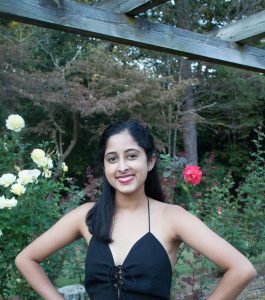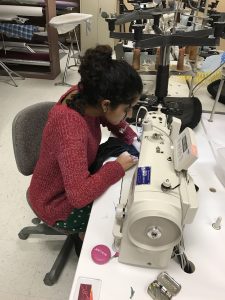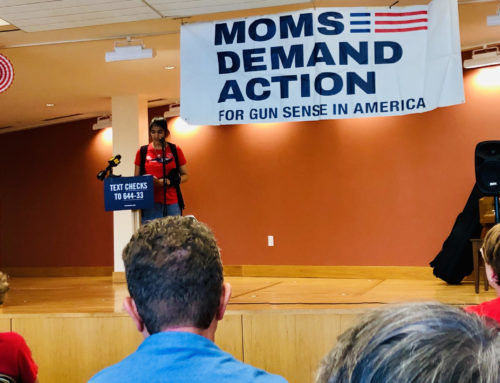This week’s Women & the Ways We Work story is debuting a new style and with two really creative women — Catherina “Cathy” Gomes and Divya Ramaswamy — in one interview. They are fashion designers!
Another side of me, which many in my professional circle don’t know about me, personally, is that I’ve been involved in theatre and fashion modeling for much of my life, in addition to all those other million things I do. In 2011, I first walked the runway modeling in Redress Raleigh and have had the privilege of being in the show every year. This year, I’m back in the show again, thrilled to be cast and working with Cathy and Divya, in Redress Raleigh on Friday, August 18th at CAM. Honestly, I feel like it could quite possibly be the best designer pairing for me yet due to their mission with their brand, 700 Rivers, and my personal commitment in life to fighting inequality and poverty, but also lifting up women and women’s issues.

Catherina Gomes
Cathy was born in Queens, NY, but grew up in Raleigh, NC. She was actually the first member of her family to be born in the United States, after her parents immigrated her from Bangladesh in 1992. Cathy got her Bachelor’s in Chemical and Biomolecular Engineering from NC State University. She followed her passion for women’s empowerment and safety to work at a small NCSU startup. The company is a nail technology company that is working on creating a nail product that changes colors to indicate the presence or absence of commonly used date rape drugs in drinks. It focuses on women’s empowerment to help protect people from drug facilitated sexual assault.

Divya Ramaswamy
Divya is from Cary, North Carolina and currently a rising junior studying fashion and textile design at NC State University. Her parents immigrated here from India and she was born 14 years later. Since she’s Indian-American and her family has lived in the U.S. for a long time, she has tried her best to maintain as much of her connection to India as possible. One way that she has been able to do this was by getting involved in a project named “Hunar Revolution,” during her freshman year of college, which aimed to empower Jaipur women by creating a brand for them to sell clothing and home textiles. Being involved in a project like this sparked her love for ethical and sustainable fashion, and encouraged her to look for new venues to pursue this interest. Divya now spends most of her days at the studio. In the future, she hopes to be creating fashionable, practical clothing that helps people better live their everyday lives.
Cathy and Divya met through a mutual friend. They met to discuss collaborating and creating the 700 Rivers brand and have been working together as the perfect team ever since. I’ll let them tell the rest of the story of who they are and how they operate, together, but also as individuals:
- What inspired 700 Rivers?
Catherina Gomes: 700 Rivers is debuting as an ethical, sustainable, sophisticated fashion brand. The name comes from the 700 rivers in Bangladesh which sustain the lives of the country’s citizens by providing villagers with water to drink, bathe, and wash their clothes and food. Likewise, the 700 Rivers brand cares to sustain the lives of its workers by providing them with fair wages for their work.The inspiration for 700 Rivers stems from the horrific working conditions that exist in large Bangladeshi garment factories, which seek to fulfill contracts regardless of worker safety. These workers are not paid fair wages and the factories they spend 15+ hours working in per day do not meet safety standards. Even with public exposure to the horrors of the garment industry worldwide after a factory collapse killed over 1,100 workers, conditions for these workers have not improved. We aim to change this. We also focus on sustainability by creating new western brand apparel using upcycled saris!
2. What is your relationship with the brand and who does what?
CG: I am the founder and CEO of 700 Rivers. I created the company and the brand to be a reflection of my worldviews and ideals: to be good and fair to others, to care for our planet, and to do it all with stylish flair! The brand also acts as an extension of myself. I come from Bangladesh but I have spent my lifetime in America.
The clothing line reflects this and represents the same crossing of two completely different cultures.
I have recently started designing apparel and am working with Divya to create a completely new look. I love our line because it shows how beautiful clothing can be when you mix two sides of the world into one product. I am the liaison between 700 Rivers and the non-governmental organization in Bangladesh that we are working with to hand-sew our apparel and products. I handle the business and logistics such as financials, marketing, supply chain management, and pre-launch preparation. The more fun and creative parts of work include fashion design, choosing product materials, and keeping consumers updated via social media and blogs!
Divya Ramaswamy: I am the lead designer for 700 Rivers, and I hold most of the creative control when it comes to designing and creating the products. My main responsibilities are to develop the clothes from start to finish, and assist in any research and development when it comes to sourcing and choosing the fabrics.
3. How does the mission of 700 Rivers impact women?
CG: The mission of 700 Rivers is to end the cycle of poverty endured by most Bangladeshi seamstresses and their families by providing them with fair living wages and safe working conditions. There are approximately 4 million people working in garment factories across Bangladesh, 85% of which are women. The workers are paid poorly and the factory owners are indifferent towards their safety. In addition to a poor salary, the workers are forced to endure unsafe, cramped, and hazardous conditions which lead to work injuries, factory fires, and building collapses.
Women, especially, must work in these factories because their lack of education leaves them with few other options. Since they are not paid enough to afford food, shelter, and education for their children, the daughters are usually the first ones to get pulled out of school to work in the factories as well to help support their families. These girls grow up and remain stuck in this vicious cycle. By paying our seamstresses a living salary, they can afford to keep their daughters in school to complete their education and break out of this cycle of poverty.
4. How do you think the fashion design experience differs for women than men and how have you approached that for the way you work?
DR: Fashion is definitely an industry that has a lot of women in it, but that does not necessarily mean that women lead the industry. A lot of the most successful design houses are still disproportionately managed by men (i.e. Lagerfield, Raf Simons, Alessandro Michele, etc.), and that means that there still aren’t a lot of female CEOs out there. I personally have not felt this disparity, but being a part of 700 Rivers, where the focus is on empowering women, I hope that we can set an example for the industry.
5. How did you get into fashion design?
CG: I got into fashion design purely because I wanted to make a difference within the industry! The one thing that the engineering industry taught me is how to tackle global challenges. I basically applied the same process we use in engineering — research the problem thoroughly, brainstorm and analyze potential solutions, design your solution process, and implement it!
DR: I’ve always been enamored by the fashion world, even when I was a little kid.
Whenever I would watch princess movies, I spent more time obsessing over the dresses they would wear than paying attention to the actual storyline.
A casual clothing obsession gradually turned into a genuine interest in practical clothing like athleticwear. I see clothing as more than just an aesthetic intrigue; fashion is a powerful tool that can be used to enact social change. That’s what makes 700 Rivers so important as a brand. It’s more than just clothes — it’s a movement.
6. Where does the magic happen?
DR: Most of it, currently, happens at the College of Textiles! I am currently constructing all of our samples that you will see at the Redress Raleigh show. All of the actual garments that are sold will be produced in Bangladesh, so we can empower the workers that live in that area.
7. When can we see products, samples, and the line really come to life?
CG: You’ll be able to start purchasing products right after the show! Two of our items from the catwalk will be available for pre-sales on the Redress Raleigh website! All future sales will be available via e-commerce on our own website. Remember that since most all our clothing is made from upcycled saris, the clothing will be available in a great variety of prints!
Be sure to follow 700 Rivers on Instagram, Facebook, and Twitter to learn more about the inspiration behind their brand, see designs, and gain more insights on their global style.
700 Rivers will be debuting in the 2017 Redress Raleigh Fashion Show at 8:00 pm on Friday, August 18th at CAM Raleigh, located at 409 W. Martin St. in downtown Raleigh, NC. The annual Redress Fashion Show is a one-of-a-kind event spotlighting conscious and responsibly-produced fashion in the Southeast. Ticket Prices: $70 Front Row; $35 General Admission. Tickets are on sale now! Buy Tickets online to get your seat to see these designs worn on the runway. Exhibition with the designers afterward so you can meet Catherina and Divya in person.
Thanks for reading the story of 700 Rivers and Catherina and Divya’s partnership in fashion design. Share in the comments how it impacted you or share it on social media. Check out next week’s weekly post on Women & the Ways We Work. Missed the others? Take a look at my blog to read them. Know someone you think should be featured or would you like to be featured? Can I help you or your organization with a storytelling project? Contact me and let’s chat.










Leave A Comment
You must be logged in to post a comment.